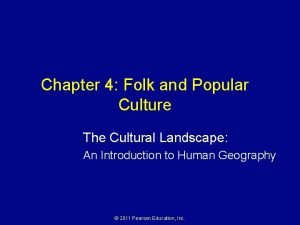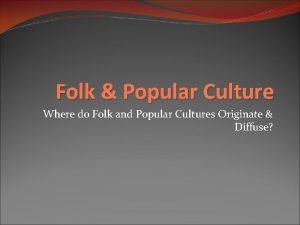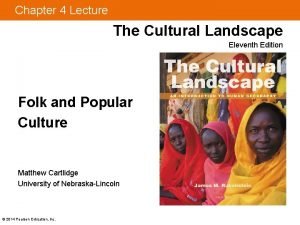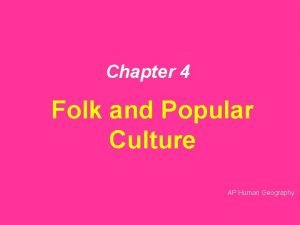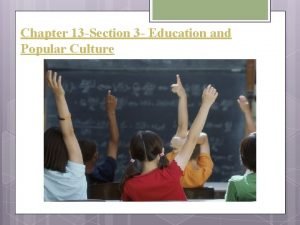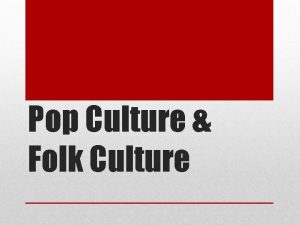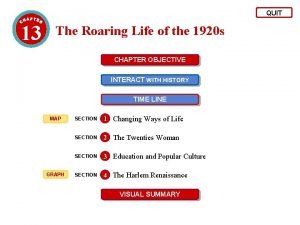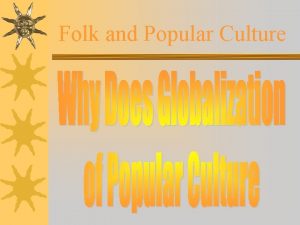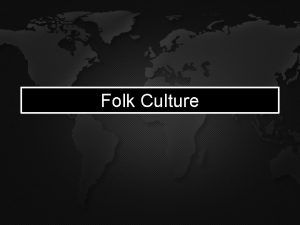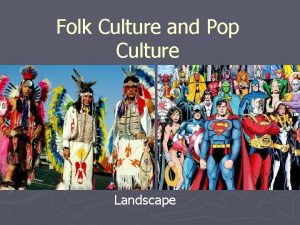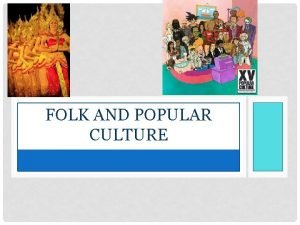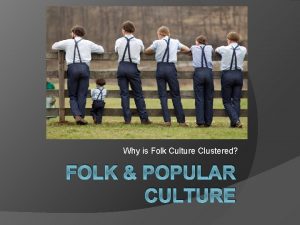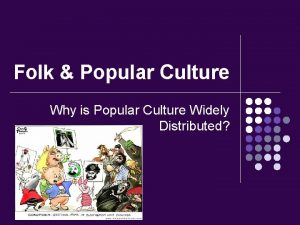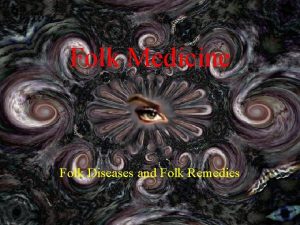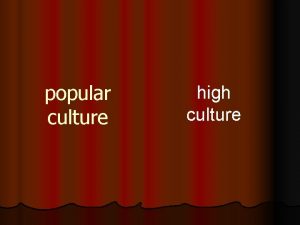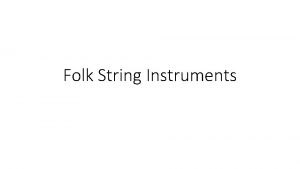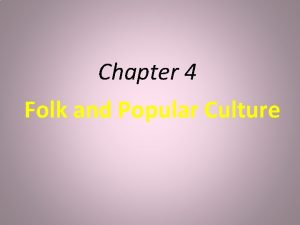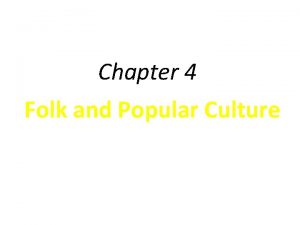FOLK and POPULAR CULTURE Folk Culture AP HG
















- Slides: 16

FOLK and POPULAR CULTURE Folk Culture AP HG Mr. Hensley SRMHS

Monday March 27 • Welcome back! I hope you had a good break! • THIS WEEK: finish culture unit (folk and popular culture) • WARM UP: Look at the graph on the left… • Give a cultural reason that explains it • Make predictions for the future

Material and Nonmaterial • Physical, visible things make up material culture • Ex: tools, house styles • Collectively, material culture makes up the built environment – the landscape as created by human beings • Nonmaterial culture is intangible – songs, stories, outlooks, beliefs, speech patterns

Review: Cultural Hearths • Recall that cultural hearths are centers of innovation and invention from which cultural traits diffuse into surrounding regions • Multilinearism – similar climates produce similar cultures (parallel development) • Diffusionism – cultural similarities spread through regions via trade contact

American Cultural Hearths • Northern hearths: French influence in Canada, Dutch in New York • Southern hearths: Tidewater (slave-based economy) and Appalachia (Scots-Irish) • Western hearths: influenced by both the Spanish and Natives (New Mexico, Texas)

Diversity or Assimilation? • Early American cultural hearths began via relocation diffusion from the ethnic group, culture and country of origin • Once in place, expansion diffusion carried culture into the interior of the continent • There has always been pressure for minority groups to assimilate into dominant cultural complex

Syncretism • Cultures can meet and blend together – this usually happens where immigrant groups intermix • It is called syncretism • Example: voodoo – West African spiritualism combines with French Catholicism • Example: Our Lady of Guadalupe – again, Catholicism meets Native traditions

Folk Culture Definition • Folk culture is the collective heritage of institutions, customs, skills and dress of a small, stable community • Folk culture is predominantly rural (homemade, handmade) • Folk culture is conservative and resistant to assimilation • Ex: traditional Japanese culture

American Folk Culture: Houses • Houses are an important component of any material culture • Vernacular houses are built without formal plans according to (folk) cultural traditions • Pictured on left: the “shotgun shack” – its inexpensive design helps with heat and humidity

House Styles: New England • Pictured is a Georgian house, with up to ten rooms, a lobby entrance and paired chimneys • The Georgian house style was brought to New England from Great Britain (relocation diffusion) • This style is still prevalent in many upscale neighborhoods

House Styles: Spanish • Influenced by the houses of the Pueblo natives, Spanish adobe houses are popular in the West • Walls are typically thick and roofs are flat (Mission style has red clay shingles) • The Spanish assimilated the Pueblo folk culture – and this vernacular house style has now diffused throughout the USA

Non-Material Folk Culture • Cuisine or cooking styles are one of the largest components of nonmaterial folk culture • Folk foods are tied to the original environment of the hearth (expansion) – ethnic foods are brought to a new environment (relocation) • Ex: grits are a folk food not an ethnic one

American Folk Foods • North: seafood chowder, lobster and baked beans • South: cornpone, grits, hush puppies (notice: all corn based) • South (Delta): gumbo and crawfish • Spanish: tortillas and tamales (corn based)

Folk Music • Southern backwoods: (bluegrass music) moral, emotional conflicts and melancholy plus religion • Western: factual, narrative songs that deal with feminine purity and personal valor • Black: emphasis on rhythm and songs that deal with “the blues”

Folk Drinks • Rum is made from sugar cane, grown in the South – folk drink • Whisky was an import from Scotland – ethnic drink • “Moonshine” or (wait for it) corn liquor is the folk drink of the Appalachians • Long history of liquor taxes • Where are the stills?

Group Work • What is this dish of meat? • What animal are we getting ready to eat? • Where are we in the world? • The answer may SURPRISE and HORRIFY you – or it may not…
 Folk culture and popular culture venn diagram
Folk culture and popular culture venn diagram Folk culture and popular culture venn diagram
Folk culture and popular culture venn diagram Homework due today
Homework due today Folk and popular culture
Folk and popular culture Folk and popular culture
Folk and popular culture How do the origins of folk and popular culture differ
How do the origins of folk and popular culture differ Chapter 4 folk and popular culture
Chapter 4 folk and popular culture Examples of folk and popular culture
Examples of folk and popular culture Why is access to folk and popular culture unequal
Why is access to folk and popular culture unequal Habit ap human geography
Habit ap human geography Folk vs pop culture
Folk vs pop culture Popular culture in media
Popular culture in media Chapter 13 section 3 education and popular culture
Chapter 13 section 3 education and popular culture Education and popular culture lesson 5 answer key
Education and popular culture lesson 5 answer key Daily life and popular culture in the 1950s
Daily life and popular culture in the 1950s The definition of pop culture
The definition of pop culture 1920 popular culture
1920 popular culture




